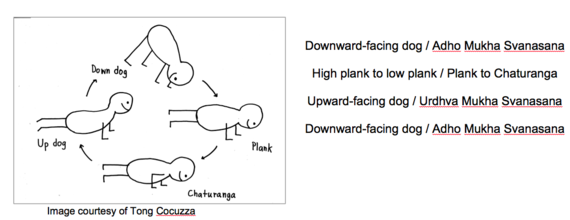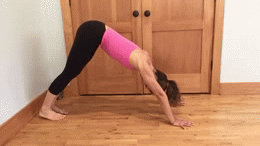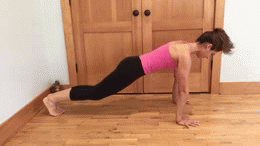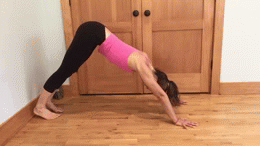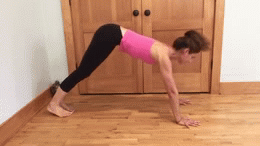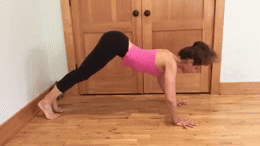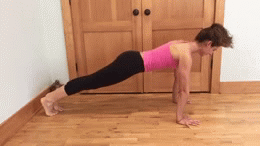To chaturanga, or not to chaturanga?
As we're working toward optimal body health and movement patterns a low plank or high chaturanga has a lot more value than a low and "traditional" chaturanga. I used to do a lot of low chaturangas with improper alignment. As I practiced more I would increasingly hunch my shoulders and my upper back grew weaker even though I seemed to be getting stronger in general. Now when I practice I altogether skip my former idea of "the classic" chaturanga.
What is chaturanga?
Chaturanga Dandasana (or four-limbed staff pose) is one of the most ubiquitous poses in vinyāsa or "flow" yoga. Chaturanga is like a low push-up pose. Beginning from a high push-up, hover your body down all in one line -- or plank -- until it's 6 inches from the floor. Whether doing a basic or challenging class, you'll likely do 10-20 chaturangas during an average flow-based class.
Plank, a high push-up position, is pretty hard in and of itself, but chaturanga is really hard to do without losing proper alignment. The traditional pattern of postures is:
Common issues in chaturanga
There are a number of common problems that we, as yoga teachers, see in this movement pattern and it explains why many yogis experience repetitive motion injuries in their shoulders and low back pain. It's in large part because their hip and shoulder girdles fall out of alignment. The most prevalent issues I see people struggling with while cycling in and out of chaturanga are:
1. The "Mick Jagger"
I know it sounds silly but it's the best description. If you've seen rock stars body slam themselves on stage like a worm, then you've seen the Mick-Jagger-style belly flop. It's when your core sinks down below the line of your knees and shoulders and you have a pronounced arch in your low back. Over time it creates a lot of stress on the sacroiliac joints and the lumbar (the low back region) in general. Usually we fall into the belly flop when we're not engaging our core strength or our arm and back muscles.
The Fix: use your knees. From high plank, lower your knees first and practice good form while becoming mindful of engaging your core and upper back (rhomboids, serratus anterior, middle trapezius). Lower the upper body all in one line (do NOT use the knees-chest-chin method) to the floor as you engage your scapulae down slightly and toward one another. This is really hard and challenging even if it's considered a "modification!"
2. The Shoulder Roll
This is when start to round our shoulder heads forward and continue to shorten and tighten those muscles that are already tight and underutilized. The upper pectorals and the front of the chest are generally pretty tight because of our everyday lives (computer use, driving, sitting, carrying bags, etc.). It again underlines why core engagement, proper alignment, and moving slowly are all key components of a safe foundation.
The Fix: lower down only 3-6 inches. Option two, and what I do a lot of, is to start in high plank and hover down 3-6 inches -- just a smidgen -- and then come into an upward-facing dog (or cobra, or skip it all and come to "down dog"). It only takes a little bit of a hover to get many of the same benefits that you do when you go all the way down, and it comes with none of the accompanying risks: Give it a try!
3. The Butt-up Funky Chicken
To be frank, this is everything falls apart! We end up recruiting from "the front" muscles, not the back muscles, as we swoop down into a lazy chaturanga with a raised bottom. Our pectoralis major and our deltoids are usually stronger and tighter (especially the pectoralis minor), while our upper back muscles are weaker. Sometimes, it'll look like a practitioner has a winged scapula (scapula alata) because he/she is muscling through chaturanga without engaging the muscles that stabilize the shoulder girdle. Not only does the winging of the scapulae impede scapulohumeral rhythm, it also blocks scapular depression / retraction. Lastly, and most importantly, because the medial border of the scapula sticks out, it looks like a chicken doing a chaturanga!
The Fix: Both "The Mick Jagger" and "The Funky Chicken" usually cause the elbows to go out to the sides like chicken wings, when actually, they should stay fairly close to your ribs -- not squeezing and propping up the ribs but hovering near them. If you're doing "the funky chicken" please consider lowering your knees to the floor and strongly engaging your upper back and serratus muscles as you lower down. It feels profoundly empowering to practice this way and instead of a funky chicken think of it more as using your pterodactyl strength to stay safe and strong in your practice.
To chaturanga, or not to chaturanga?
Your new, rebooted chaturanga will help you avoid excessive wear on your joints, it'll decrease compression in the back, and it'll actually feel like a great relief to the upper back to be engaged and utilized. It'll be fantastic, trust me: It's time to kick your old chaturanga to the curb!
Bio of my amazing collaborator, Lara Heimann.
Drawing from her background as a physical therapist, Lara Heimann has combined her love of anatomy, creative movement and functional training to help people move better and do better. Lara owns YogaStream studio in Princeton, NJ and directs its YA-certified teacher training school.
A special thank you to Lara Heimann for modeling all of the funky and corrected poses.
